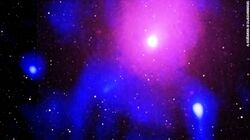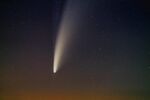Astronomy:Ophiuchus Supercluster explosion
According to NASA and others, the Ophiuchus Supercluster explosion was the biggest explosion seen in the observable universe since the MS 0735+74 explosion.[1][2]
| Event type | Explosion |
|---|---|
| Instrument | Chandra X-ray Observatory, XMM-Newton, Murchison Widefield Array, Giant Metrewave Radio Telescope |
| Constellation | Ophiuchus |
| Distance | 390 million light-years |
This extremely powerful eruption occurred in the Ophiuchus Supercluster, which is located about 390 million light-years from Earth. A paper describing these results appeared online on 27 February 2020 in The Astrophysical Journal, and a preprint is available on arXiv.[3] This explosion was caused by a supermassive black hole spraying out jets of extremely active particles.[4]. Its total huge energy is estimated to 5 X 1061 erg, or 5 X 1054 J.[3] Furthermore, the cavity produced by the outburst is so big that would be possible to put 15 galaxies of Milky Way's dimensions in a row.[5]
The authors of this paper are Simona Giancintucci (Naval Research Laboratory, Washington, DC), Maxim Markevitch (Goddard Space Flight Center, Greenbelt, Maryland), Melanie Johnston-Hollitt (International Centre for Radio Astronomy, Australia), Daniel Wik (University of Utah), Qian Wang (University of Utah), and Tracy Clarke (Naval Research Laboratory). The 2016 paper by Norbert Werner et al. was published in the Monthly Notices of the Royal Astronomical Society.
This observation is a result of collaboration among various space-based and Earth-based observatories including the Hubble Space Telescope, the Chandra X-ray Observatory, ESA’s XMM Newton X-ray space observatory and radio data from the Murchison Widefield Array (MWA) in Australia and the Giant Metrewave Radio Telescope (GMRT) in India.[6][7]
References
- ↑ "Ophiuchus Galaxy Cluster". NASA. 27 February 2020. https://www.nasa.gov/mission_pages/chandra/images/ophiuchus-galaxy-cluster.html. Retrieved 28 February 2020.
- ↑ "Chandra Press Room :: Most Powerful Eruption in the Universe Discovered :: January 5, 2005". https://chandra.harvard.edu/press/05_releases/press_010505.html.
- ↑ 3.0 3.1 Giacintucci, S.; Markevitch, M.; Johnston-Hollitt, M.; Wik, D. R.; Wang, Q. H. S.; Clarke, T. E. (4 February 2020). "Discovery of a giant radio fossil in the Ophiuchus galaxy cluster". The Astrophysical Journal 891 (1): 1. doi:10.3847/1538-4357/ab6a9d. Bibcode: 2020ApJ...891....1G.
- ↑ Werner, N.; Zhuravleva, I.; Canning, R. E. A.; Allen, S. W.; King, A. L.; Sanders, J. S.; Simionescu, A.; Taylor, G. B. et al. (August 2016). "Deep Chandra study of the truncated cool core of the Ophiuchus cluster" (in en). MNRAS 460 (3): 2752–2764. doi:10.1093/mnras/stw1171. ISSN 0035-8711. Bibcode: 2016MNRAS.460.2752W.
- ↑ February 2020, Mike Wall 27. "Boom! Scientists spot the biggest known explosion in the universe". https://www.space.com/biggest-cosmic-explosion-universe-discovery.html.
- ↑ "Biggest cosmic explosion ever detected left huge dent in space". The Guardian. 27 February 2020. https://www.theguardian.com/science/2020/feb/27/biggest-cosmic-explosion-ever-detected-makes-huge-dent-in-space. Retrieved 28 February 2020.
- ↑ Giacintucci, S.; Markevitch, M.; Johnston-Hollitt, M.; Wik, D. R.; Wang, Q. H. S.; Clarke, T. E. (2020-02-04). "Discovery of a giant radio fossil in the Ophiuchus galaxy cluster". The Astrophysical Journal 891 (1): 1. doi:10.3847/1538-4357/ab6a9d. Bibcode: 2020ApJ...891....1G.





